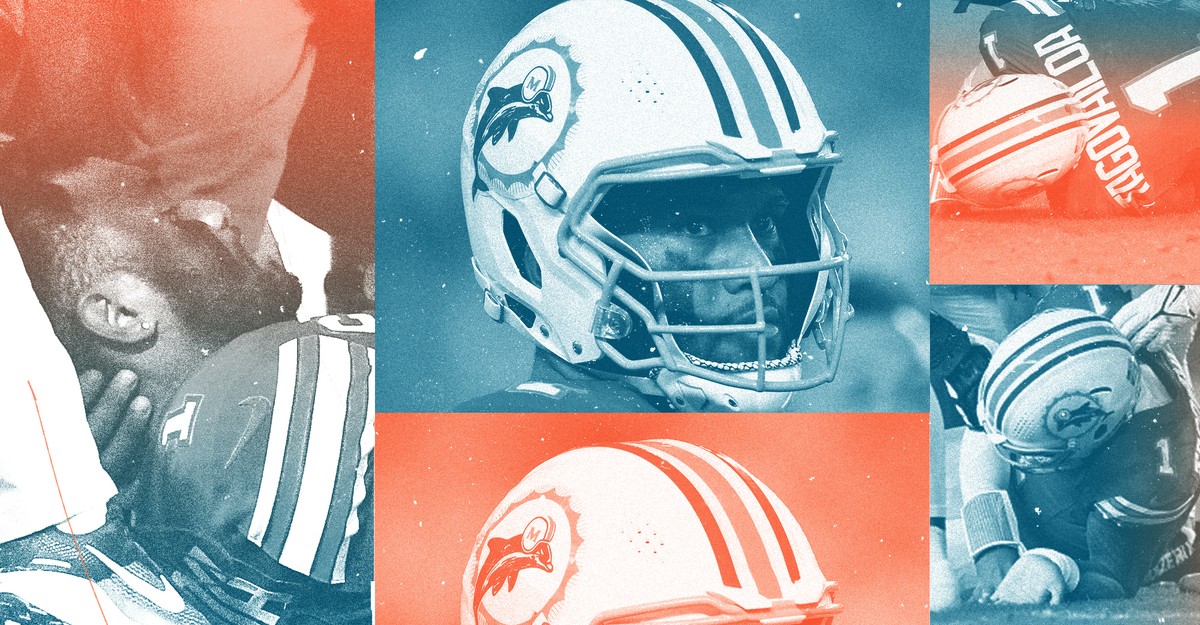
A grim and all too familiar scene played out on Thursday night as the Miami Dolphins faced off against the Buffalo Bills. Racing toward the end zone, the Dolphins quarterback Tua Tagovailoa crashed headfirst into a Bills defender. Tagovailoa went limp, his head ricocheting off the field while his right arm involuntarily swung upward, fingers clawing at the sky. As Tagovailoa tried to get up, he looked dazed. Minutes later, he was taken out of the game with a concussion.
Tagovailoa has become something of a poster child for football’s concussion problem: Going back to his senior year of college, the 26-year-old has had at least four of them in five years. Most notably, in 2022, he was knocked unconscious after hitting his head against the turf while playing the Cincinnati Bengals, and had to be taken off the field in a stretcher. He returned later that season, before suffering another concussion in a game against the Green Bay Packers. After the 2022 season, Tagovailoa considered retiring, weighing the long-term effects of the repeat head injuries.
Since Thursday night, the calls for Tagovailoa to retire have crescendoed. “He’s going to live longer than he’s going to play football. Take care of your family,” Antonio Pierce, the head coach of the Las Vegas Raiders, told reporters in a press conference. “This is something that can affect you long-term … For me, it’s time to move on,” Tony Gonzalez, a Hall of Fame tight end turned announcer, said on the broadcast after the Bills game. Concussions are linked to personality changes, cognitive impairment, and mental illness, which sometimes manifest years or decades after the initial injury. Repeat injuries can lead to chronic traumatic encephalopathy (CTE), a degenerative brain disease associated with memory loss and depression that has been diagnosed in hundreds of former players.
Whether Tagovailoa will return to the game is not yet certain. But it’s unclear what risks he faces by playing again. Four concussions seems like a lot; whether that’s too many is hard to say. There’s no “magic number that says that beyond X number of concussions, you really need to stop,” Thomas McAllister, a traumatic-brain-injury expert at Indiana University School of Medicine, told me. Unfortunately, this also makes it impossible to know when a person has had one too many. Not everyone who has multiple concussions goes on to develop CTE, while others have done so without ever knowingly getting a concussion.
Still, experts generally agree on a few principles, all of which point to the dangers of repeat blows. People who have had many concussions over a relatively short period tend to take longer to recover from subsequent ones. The usual short-term symptoms—headaches, nausea, and sensitivity to light, among others—linger longer than usual. With successive concussions, people can be more prone to future ones. The brain becomes sensitive; with each blow, less force is required to cause a concussion.
Beyond that, few things are certain. The harder a person is hit, the more likely they are to be concussed, but people respond differently to the same kind of blow. Typically, concussions occur with strikes of 90 to 100 g-force. “If I were subjected to an 80-g concussion, I might be down for the count. You might bounce right up and go about your business,” McAllister said. One explanation for this variability is that the brain might be “primed” for concussion by any previous, smaller hits earlier in a game, and the next large blow is the “straw that breaks the camel’s back.”
Early data from McAllister’s ongoing research suggest that people likely also have different thresholds for tolerating repeat concussions. (He’s co-leading the world’s largest concussion study, which includes more than 53,000 college athletes and military cadets.) Some may be able to withstand a high number and quickly recover each time. The problem is that “we’re not able to say that this is the one that puts you over the top,” McAllister said.
When it comes to predicting long-term damage, the number of concussions may not be what matters most. A study of NFL players published last year suggested that the symptoms experienced immediately following a concussion—in particular, loss of consciousness—are a better predictor of future cognitive decline than the number of diagnosed concussions. Some researchers argue that in rare cases, a concussion that occurs before a previous one has resolved can lead to a condition called second-impact syndrome, which can cause severe neurological damage and even death.
Experts must rely on certain indicators to discern when concussions have raised the risk of permanent harm. The red flags include when concussions start happening more frequently and with less of an associated stimulus, and when a longer interval is needed for a person to return to their baseline, as determined through regular neurocognitive testing. All of the data support the importance of having a standardized assessment and waiting period before bringing players back onto the field, McAllister told me. The NFL’s concussion protocol includes instructions on when a player must be removed from the field, how long he should be monitored, and which tests he must pass to return to playing full-time.
There’s no question that repeat concussions are detrimental. The problem for Tagovailoa—and the future of the NFL—is that it’s impossible to quantify just how much damage they cause. If only the league could set a hard limit on the number of concussions that players were permitted to sustain in a certain period, Tagovailoa would face a much easier choice. But that’s not how concussions work. Instead, they are deeply individual, their effects inseparable from the player’s history and biology. As long as so many unknowns about concussions remain, players will keep finding themselves in Tagovailoa’s position, weighing their career against the rest of their life.




